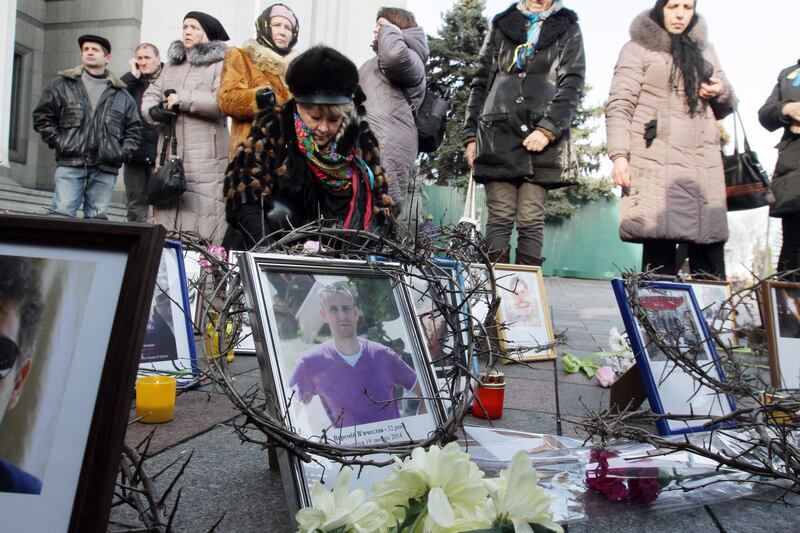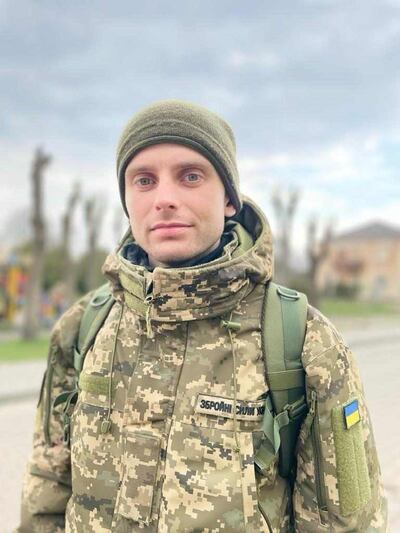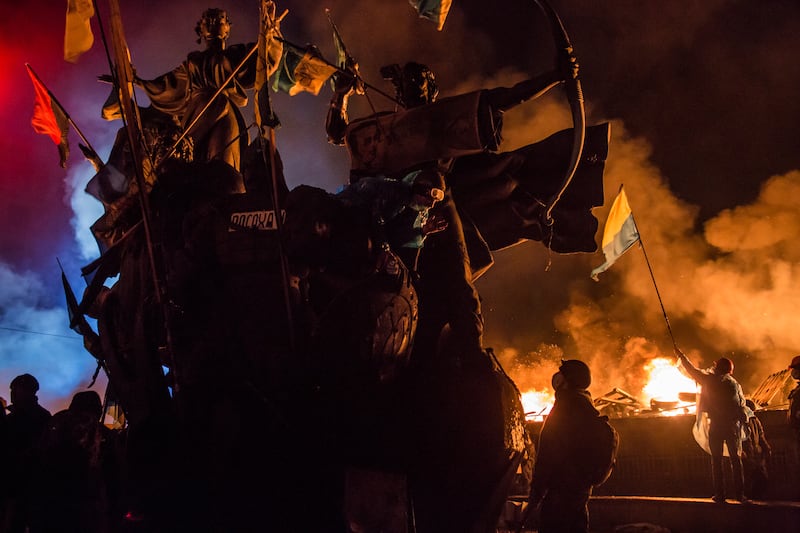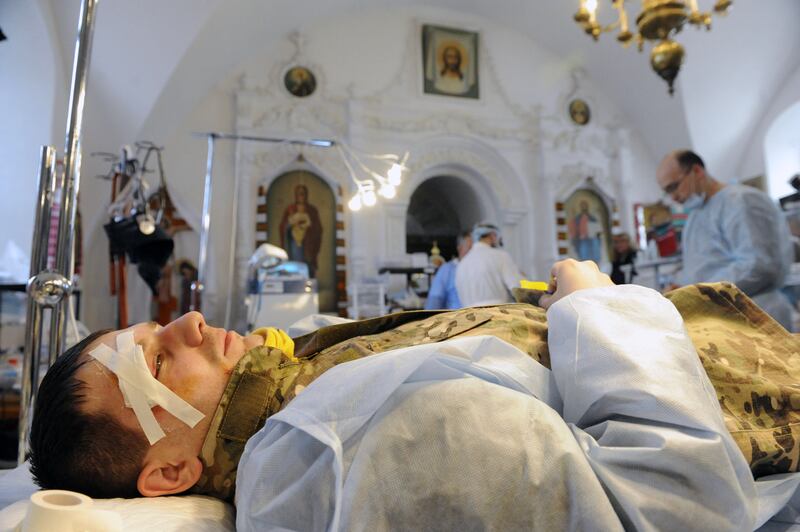During Ukraine’s decade-long fight to finally be free from Russia, St Michael’s monastery in central Kyiv has become a place where people come to mourn their dead, revive their spirits and then return, whether soldier or civilian, to their part in the battle.
The blue-and-white outer walls of the monastery are now covered with photographs of fallen soldiers, where Ukrainians seek out the faces of lost loved ones or try to grasp the human cost of their nation’s refusal to bow to Moscow and occupation; all too often, the bells ring for the funeral of another fighter, medic or volunteer killed at the front.
Ten years ago, golden-domed St Michael’s served as a field hospital for pro-democracy protesters during what Ukrainians call the Revolution of Dignity. When it culminated on February 20th, 2014, with riot police shooting dozens of people on nearby Maidan square, demonstrators laid out the bloodied bodies of their comrades in the monastery grounds.
[ Ukraine’s hopes for justice fade six years after Maidan massacreOpens in new window ]
“It’s all interconnected. This is one chain of events, from the first protests on Maidan to now,” says Levko, a Ukrainian soldier in his early 30s who does not want his surname to be published for security reasons.
READ MORE

Ukraine’s then president Viktor Yanukovich fled to Moscow after the mass killings on Maidan, and as Ukraine pledged to turn west and pursue EU and Nato membership, Russia quickly annexed Crimea and formed armed militias to seize parts of the eastern Donbas area. Two years ago, the Kremlin turned that conflict into a devastating full-scale war.
Most Ukrainians tried to continue with their pre-Maidan lives through the crises in Crimea and Donbas, but Russia’s all-out invasion put an end to that, killing and injuring hundreds of thousands of soldiers and tens of thousands of civilians, and forcing millions of Ukrainians to flee abroad to escape the heaviest fighting in Europe since 1945.
After Maidan, Levko worked as an architect and set up a business with a partner in the UK. But last year he joined the army and now serves in a reconnaissance unit in Donbas; like so many of his compatriots, his personal path has now merged, in a way he could never have imagined, with the hard road taken by Ukraine.
“Maidan was a turning point,” he says by phone from a location that he estimates is 10km from the front line.
[ Kyiv blames Putin aide for Maidan square killings by snipersOpens in new window ]
“There was a change in mentality, people started going back to their roots and the Ukrainian language became dominant [over Russian]. And all these processes really sped up with the full invasion,” he adds.
“Yanukovich was a mistake. Ukraine was naturally, but slowly, turning back to the West, where we had lived until at least the 18th century, until we were swallowed by the Russian empire. The Yanukovich regime was a contradiction to historical logic and Maidan was a response to that,” Levko says.
“But when you make such a sharp move, the empire reacts, wakes up and goes on the attack… We’ve been captives for centuries, and now is the time to end that. We are moving to the West, but first we must face and defeat the threat from the East,” he adds. “The price is very high – but this is a historic mission and a historic time.”

Levko first travelled from Lviv in western Ukraine to Maidan in late November 2013, before protesters built a vast tent camp on the square in the heart of Kyiv, surrounded by barricades of tyres and planks and old metal, where they would hold out through a freezing winter until the deadly but victorious days of the following February.
The trigger for protests was Yanukovich’s decision to end talks with Brussels on a landmark deal to deepen political and trade ties with the EU, amid mounting criticism from Russian president Vladimir Putin that it would not only be a threat to close economic ties between his country and Ukraine, but a betrayal of their shared Slavic history and identity.
[ Kyiv Maidan’s demand to know who killed ‘Heavenly Hundred’ falling on deaf earsOpens in new window ]
“There had always been corruption but under Yanukovich it was really terrible,” Levko says. “Everyone wanted changes, whether you were an ordinary worker or a businessman. We wanted to go towards Europe because it meant hope and order. Finally we had got this hope, and then Yanukovich wanted to take it away from us.”
‘The Yanukovich regime was a contradiction to historical logic and Maidan was a response to that’
— Levko
When Yanukovich refused to sign the deal at a summit with EU leaders on November 29th, thousands of people converged on Maidan, which is formally known as Independence Square, waving Ukrainian and EU flags and demanding his resignation.
Most protesters went home at about midnight and only a few dozen, mostly younger ones, stayed on through the night, feeding firewood into old metal drums to stay warm and snatching some sleep in a tent that stood on the otherwise almost empty square.

Iryna Bilan, then 23, had planned to take a train home to Lviv that night, having spent three days on Maidan handing out food, warm clothes, blankets and other things that people donated for the protesters.
“As I was heading for the metro, I realised I couldn’t leave. People who I’d been volunteering with were still there, including a couple of girls who were younger and maybe even smaller than me. When I pictured them and other friends who were staying, I decided to go back and spend one more night on Maidan,” she says.

There had been rumours that the notorious “Berkut” unit of riot police might try to clear Maidan that night, and at about 4am Bilan saw them marching onto the square.
“I went into the tent and woke up the other girls and told them to run,” Bilan says.
The few remaining protesters had agreed that if Berkut came, they would all gather in the arch at the base of the independence monument on the square, with women middle and men around the outside in a protective ring.
“We tried to sing the national anthem to keep our spirits up, but Berkut quickly broke through the ring. As they attacked, most of us ran away into the subway passages under Maidan. I was with the father of two other girls but we lost them. I didn’t know Kyiv very well then and wasn’t sure where to go. But we all met up again at St Michael’s monastery.”

The priests in the monastery, which sits on higher ground just 600m from Maidan, opened its doors to the protesters and Berkut did not pursue them inside. From then on, St Michael’s would be a place of refuge and symbol of resistance for the revolution.
When a television station aired footage of the black-clad Berkut police beating young and unarmed protesters on Maidan, relatively small rallies for reforms and closer ties with Europe spiralled into a mass movement committed to the radical transformation of Ukraine.
Two days after the Berkut attack, hundreds of thousands of people gathered in Kyiv and other cities to denounce the corruption and impunity that had blighted Ukraine since independence in 1991, and demand a final break with a Russia that still enjoyed huge influence in the country and sought to prop up Yanukovich’s increasingly authoritarian regime.
[ Tempers fray far from frontline as Ukraine seeks new influx of troopsOpens in new window ]
When Bilan returned to Kyiv in mid-December, the protest camp on Maidan was like a self-contained village – an “island of freedom”, some Ukrainians called it – wreathed in woodsmoke from braziers, steam from vats of soup and tea, and songs and speeches from a big stage at the centre of the square. Thousands of volunteers were its lifeblood, even as Russian propaganda claimed that those involved were being paid by the US state department or drugged by something in the free food.
“The feeling was amazing. It was like a camp and a fortress and you felt so safe. All the emotions were so positive… and we thought we could actually make a difference in a peaceful way. People were just coming and living there, contributing their time and resources. It was better than any music festival, until it stopped being that way.”
‘As they attacked, most of us ran away into the subway passages under Maidan’
— Iryna Bilan
On January 16th, 2014, Yanukovich’s regime passed laws that effectively outlawed public protest and severely restricted free speech and the work of civil society – taking Ukraine down the same road towards authoritarianism as Russia and its closest ally, Belarus.
Six days later, the first two protesters were killed on Maidan, a third suffered wounds that would prove fatal, and the body of a missing activist was found outside Kyiv.
With the so-called dictatorship laws and subsequent bloodshed, any room for compromise vanished. Constant fear of an armed Berkut attack hung over Maidan, where protesters who were prepared to fight now had more authority than opposition politicians.
Deadly street fighting broke out on February 18th, and two days later gunfire reverberated around Maidan as Berkut and other units fired on protesters advancing towards the presidential administration. Most carried nothing more than makeshift shields and plastic helmets, but Yanukovich’s officials claimed that gunmen shot dead 13 police officers and wounded many others.
Dozens of demonstrators were killed, and several lay on the bare earth behind St Michael’s monastery until shocked friends from Maidan tracked them down; February 20th is now the day on which Ukraine honours the “Heavenly Hundred” who died during the revolution.
Yanukovich and his entourage fled Kyiv on the night of February 21st and sought protection from Putin, who over the following weeks would seize Crimea and foment war in Donbas, where Levko, the architect, is now serving as a soldier.
“Everyone was shocked,” he says of the bloody end to Maidan.
“It was my father’s birthday on February 23rd and we were just watching the television and crying. Is this the price of victory, we wondered. And we didn’t realise it was just the beginning.”
- Sign up for push alerts and have the best news, analysis and comment delivered directly to your phone
- Find The Irish Times on WhatsApp and stay up to date
- Our In The News podcast is now published daily - Find the latest episode here





















